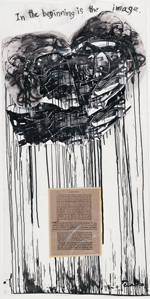 |  |
 |
| | |
| |
|
|
| |
|
|
|
|
|
| What is the difference between spirituality and religion? Religion involves a social structure and an authority structure. Spirituality does not. And where does art fit? |
| | |  |
| | | Just above is an image of Junko's work, Concerning Art and Religion, No. 7 (2003), "In the Beginning is the Image." paper, acetate and acrylic on mylar. 84" x 42". Click on it to see a closer view of the image itself.
Here is the opening passage from Chapter One of the book, titled "Objects as Visitants": |
| | | It has been a hundred years since artists stopped feeling themselves compelled to paint glorious subjects. One of the breakthroughs of so-called “modern art”—the art of the early 20th Century—was that the greatest artists began to refuse to pander to the narcissism of the aristocracy and of the church. Instead of painting heroic scenes of war showing uniformed generals on horseback, Picasso painted Guernica—an entirely different image of war. The grand cathedrals of earlier centuries gave way to the blurry facades of Rouen Cathedral as painted by Monet, or to the humble structure of Van Gogh’s Church Tower at Nuenen. Instead of the clean-faced Christ so familiar from earlier times, Rouault gave us a distraught, jumbled Head of Christ, drawn with confused lines that show him as sorrowful—not glorious. Even the human figure was seen in a different way: instead of Michelangelo’s David, we got the strange figures of Henry Moore and of Giacometti. And artists began to paint things which had never been painted before: Van Gogh painted peasants at their dinner table—as if it were a Last Supper; he painted an old worn-out pair of shoes with great intensity. And artists began to paint abstracts—compositions which had no referents outside themselves. |
| | | When the artist is showing us a great cathedral, or the figure of Christ on the cross, or a beautiful woman, or a wondrous landscape, we know why he is painting it and we know what we are expected to feel. The painting reaffirms values which the artist believes we share, and we are expected to admire the art to the extent that we are persuaded that the artist has done justice to his subject. But when the subject is something other than intrinsically noble or glorious we have to ask, Why is the artist painting this? What justice can one do to an old weather-beaten pair of shoes? What values can we affirm as we look at the abstracts of Kandinsky or at the figures of de Kooning? |
| | | In Junko’s case, these questions present themselves to us with particular urgency. For most of the objects which move Junko to paint are objects which no one else might consider even worth looking at: dead flowers, roots, burls, parts of broken engines—commonplace things in which Junko finds a creative force yearning for expression. In this chapter, we explore the intense relationship between Junko and her subjects—a relationship which I call “encounter”: it grows out of a connection between qualities in the objects and qualities in Junko which attract and transform each other. It goes beyond mere interest or even fascination: it is a personal kind of interaction between Junko and her subjects which could not possibly have been understood before this time in history, for to understand it requires a modern psychological consciousness. Without such a consciousness, Junko’s viewers could not appreciate her radical rejection of all forms of malignant narcissism nor recognize her frequent evocation of Jungian archetypes. Nor could her art have been appreciated before Western viewers were exposed to Eastern styles of empathy which arise from the awareness of a spirit inside everything. |
| |
| |
| |
|
|
|
|
|
|
|
|
|
|
|
| |
| |
|
| |